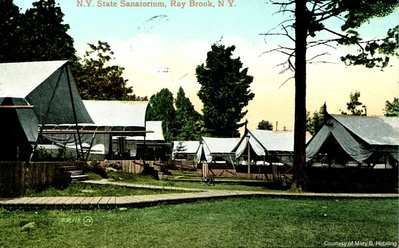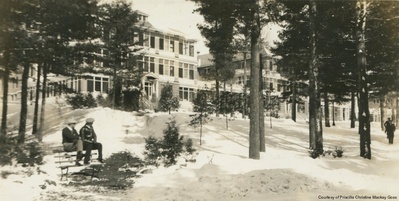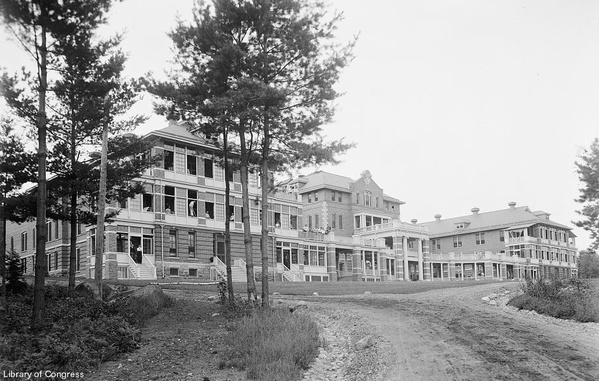 Construction of the State Sanatorium at Ray Brook (Detroit Publishing Co. 1905-20 The New York State Hospital for Incipient Pulmonary Tuberculosis (as it was originally named), was commonly known simply as "Ray Brook." Opened in 1904 in the hamlet of Ray Brook, it was the first New York State-operated tuberculosis sanatorium, and the second in the United States, after Massachusetts. After a protracted study of alternative sites, New York State chose to establish its hospital in the highly-regarded fresh air of the Adirondack Mountains, near the critical mass of tuberculosis experts in Saranac Lake.
Construction of the State Sanatorium at Ray Brook (Detroit Publishing Co. 1905-20 The New York State Hospital for Incipient Pulmonary Tuberculosis (as it was originally named), was commonly known simply as "Ray Brook." Opened in 1904 in the hamlet of Ray Brook, it was the first New York State-operated tuberculosis sanatorium, and the second in the United States, after Massachusetts. After a protracted study of alternative sites, New York State chose to establish its hospital in the highly-regarded fresh air of the Adirondack Mountains, near the critical mass of tuberculosis experts in Saranac Lake.
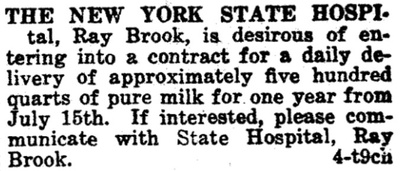 Lake Placid News, June 30, 1922Although medical developments made sanatoria obsolete starting in the mid-1950s, the State Hospital at Ray Brook continued to operate until the mid-1960s. The property was then transferred from the Department of Health to the new Drug Addiction Control Commission, combining enforcement and treatment; in 1971 the new facility opened as the Ray Brook Rehabilitation Center, housing 70 to 130 women addicts. However, it was judged a failure, and closed within five years. It was succeeded by a camp program for adult inmates, "Camp Adirondack". Working with the Department of Environmental Conservation, "campmen", as inmates were known, were employed in logging, sawmill, wildlife preservation, construction of campsites and snowmobile and cross-country ski trails, and construction of a toboggan run at the Mount Pisgah ski area. For a time, the
Lake Placid News, June 30, 1922Although medical developments made sanatoria obsolete starting in the mid-1950s, the State Hospital at Ray Brook continued to operate until the mid-1960s. The property was then transferred from the Department of Health to the new Drug Addiction Control Commission, combining enforcement and treatment; in 1971 the new facility opened as the Ray Brook Rehabilitation Center, housing 70 to 130 women addicts. However, it was judged a failure, and closed within five years. It was succeeded by a camp program for adult inmates, "Camp Adirondack". Working with the Department of Environmental Conservation, "campmen", as inmates were known, were employed in logging, sawmill, wildlife preservation, construction of campsites and snowmobile and cross-country ski trails, and construction of a toboggan run at the Mount Pisgah ski area. For a time, the
campmen also aided local volunteers in constructing the Ice Palace each winter for the Saranac Lake Winter Carnival.
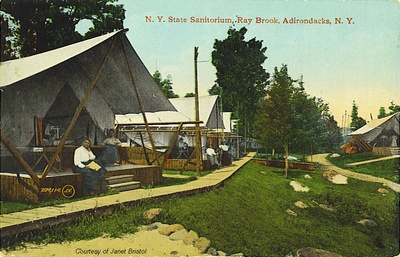 NY State Hospital at Ray Brook - 1902
NY State Hospital at Ray Brook - 1902
With the selection of Lake Placid for the 1980 Winter Olympics" the inmates worked on the Olympic trails at Mount Van Hoevenburg. The camp facilities were used for Olympic staff housing, which led to renovation of the water treatment plant, sewage system, housing and food service areas. During the games, the inmates were relocated to other prison facilities in the state, and were replaced by 900 State Police and 300 U.S. Customs Bureau personnel, National Guard and security forces of foreign governments who provided security for the Games. Two hundred acres of the Camp Adirondack was used as the site for the Olympic Village; after the games it became a new federal prison, the Federal Correctional Institution at Ray Brook.
The newly improved facilities allowed a substantial increase in the prison population, which led to the erection of the first security fence around the perimeter of the complex. In 1981, Camp Adirondack was designated a medium-security facility and renamed the Adirondack Correctional Facility, rated as a 700-man, medium-security prison, and employed 311. In 2018, it was renamed the Adirondack Adolescent Offender Facility for incarcerated adolescents. As of 2020 it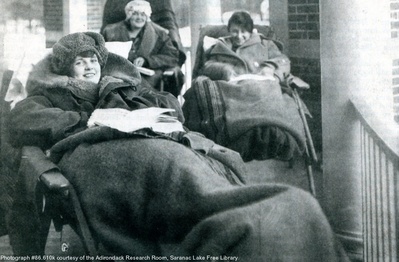 Curing at Ray Brook, undated. Adirondack Daily Enterprise, January 8, 2005 s purpose has been changed to housing aging prisoners.
Curing at Ray Brook, undated. Adirondack Daily Enterprise, January 8, 2005 s purpose has been changed to housing aging prisoners.
Literary connections Sylvia Plath's college boyfriend, Dick Norton (Buddy, of The Bell Jar) contracted tuberculosis while at Harvard University, and was sent to Ray Brook for treatment. Plath visited him in 1952, and broke her leg while skiing on Mount Pisgah in nearby Saranac Lake. 1Andrea Barrett's 2007 novel The Air We Breathe is based on a fictionalized Ray Brook Sanatorium. 2
Adirondack Daily Enterprise, October 17, 2018
First teens to arrive at Ray Brook state prison this month
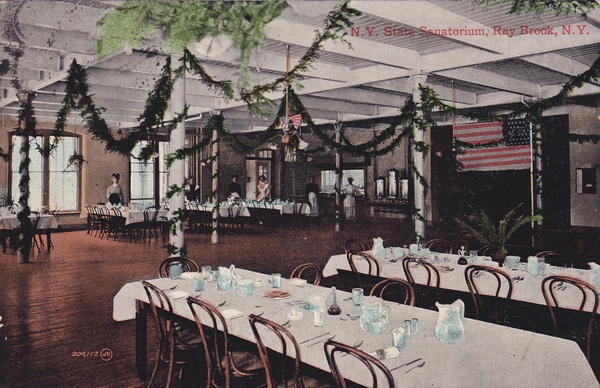 Colorized postcard showing the dining room at Ray Brook Sanatorium. The room is decorated, likely for Christmas. Undated.
Colorized postcard showing the dining room at Ray Brook Sanatorium. The room is decorated, likely for Christmas. Undated.
Historic Saranac Lake collection, #2021.3.97.
Gift of the Florence Wright Tuberculosis Postcard Collection.
The Adirondack Correctional Facility in Ray Brook has been renamed the Adirondack Adolescent Offender Facility and will receive its first incarcerated adolescents later this month. . . . The medium-security prison was revamped as part of Gov. Andrew Cuomo's Raise the Age law that raised the age of criminal responsibility from 16 to 18. . . . The overall capacity of the Adirondack Adolescent Offender Facility will not exceed 150. . . .
The Adirondack News, October 20, 1900
A hearing was given by the Forest Preserve board and State Board of Health in the senate chamber at Albany Thursday on the proposition to place the state hospital for consumptives at Lake Clear. Letters were read opposing the Lake Clear site from Whitelaw Reid and Anson Phelps Stokes, and Dr. Ransom of Clinton prison earnestly advocated the selectlon of the Dannemora site, claiming less humidity in the air there and urging that at Dannemora there was an abundance of labor in the prison population and the state owns plenty of land there for the site. Dr. Vanderver, of Albany, also favored the Dannemora site, but Mr. Townsend and Dr. Pryot, of the hospital commission, advocated the Lake Clear site as the best. A number of Clinton county people appeared to urge Dannemora's claims and it was agreed that another hearing will be given on the matter to the Dannemora advocates at a later day but probably not till after election. That is wise as some of the Clinton county men are evidently making a political thing out of it.—Farmer.
Plattsburgh Press Republican, 100 Years Ago — Lookback: Week of Jan. 28-Feb. 3, 1908
In its annual report to the Legislature, the State Hospital at Ray Brook for the treatment of incipient tuberculosis says there has been a steady growth in the population of the hospital. During the year, 287 were admitted and 267 were discharged.
Adirondack Daily Enterprise, December 29, 1926
Two Hundred Entertained at Annual Holiday Ball Last Night at Ray Brook
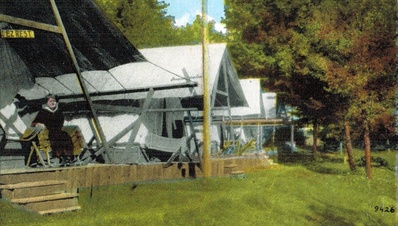 Postcard captioned "Outdoor Life at New York State Sanatorium, Ray Brook, Adirondacks, N. Y."
Postcard captioned "Outdoor Life at New York State Sanatorium, Ray Brook, Adirondacks, N. Y."
Courtesy of Noreen OslanderThe annual Christmas ball at Ray Brook Sanatorium was held in the great dining room of the main building last evening. For many years past Dr. H. A. Bray, medical superintendent, Miss L. Cleland, staff manager, and J. J. Farrington, steward, have entertained patients and everyone connected with the sanatorium at a dance during Christmas holiday week.
Patients and the staff of Trudeau sanatorium received invitation to the event last evening and neighboring families at Ray Brook were also entertained, the gathering numbering in all more than 200 guests. Doc Bray's orchestra, of this village, played for the dancing.
One of the most enjoyable features of the evening was a "Paul Jones" during which all the guests had opportunity become acquainted with each other, and formalities gave way to a general atmosphere of merriment and good fellowship. The orchestra generously responded with several encores to the most popular numbers of the dance program. Dancing continued until midnight.
Decorations of evergreen and the customary color effects in red and green trimmings that were arranged in the dining room for Christmas day made an appropriately festive setting for the annual dance, which was further enhanced by the pretty, colorful evening gowns worn by the feminine guests. Refreshments were served during the evening.
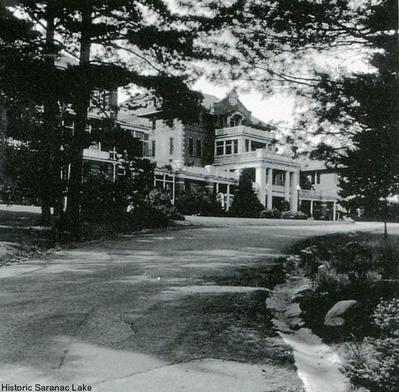 Entrance to Ray Brook. From Saranac 1937-1940 by Richard H. Ray"
Entrance to Ray Brook. From Saranac 1937-1940 by Richard H. Ray"
When financial circumstances forced Richard H. Ray to move from Trudeau Sanatorium to state supported Ray Brook in 1938, he had his doubts at first (from Saranac 1937-1940)
Feeling that I might be moving from a first rate sanatorium to a poor relations workhouse, the sight of a lovely little 9-hole pitch and putt golf course across the road from the imposing portico of the main building got my immediate attention. An institution where you took your exercise on a golf course just couldn't be all bad. Trudeau had nothing to compare to this! And when I went home two years later, I was still sort of enchanted by the place. Every sanatorium probably had its detractors, but I felt that Ray Brook would have to lock the doors and take away my mail privileges before I would knock it.
Adirondack Daily Enterprise, June 16, 1952
MALE CHORUS AT RAY BROOK
Twenty members of the Plattsburg Glee Club under the direction of Frank Provost and Joseph Lombardoni with his violin, entertained at the Ray Brook State Hospital last evening.
The male chorus sang with a will, might, and main in rendering sea chanteys and such as: "The Drum" and Romberg's "Stouthearted Men". Of the spirituals, folk tunes and hymnals which comprised their diversified program, some renditions were: Gerhart's "Dry Bones"; Ringwold's "Sweet and Low"; Grieg's "Brothers Sing On"; Cook's "Swing Along"! and of their chosen four by Bartholomew, one was "Steal Away". Mrs. Madeline Ryan accompanied them on the piano.
Violinist Joseph Lombardoni, one time resident of Saranac Lake, delighted all with Drdla's "Souvenir"; Kreisler's "Liebsfreud" and "Schon Rosmarin"; and Nero's "Hot Canary".
He modestly affirmed that he had spent 10 years studying music in Europe, adding that it always had been a pleasurable but secondary interest. For the past 18 years, Mr. Lombardoni has been the Metropolitan Life Insurance Company's representative in the Dannemora area. Miss Grace Beldon was his piano accompanist.
[…]
At the program's end, a bit later between sips of coffee, the Chorus spontaneously gave forth with more song. Hospital emcee Joseph Segriff and radioman Gordon Cardwell quickly re-hooked up the microphone, and the entire hospital heard encores as never before.
 Directory listing for Ray Brook as it appeared in "A Tuberculosis Directory," 1911. This directory was published by the National Association for the Study and Prevention of Tuberculosis.
Directory listing for Ray Brook as it appeared in "A Tuberculosis Directory," 1911. This directory was published by the National Association for the Study and Prevention of Tuberculosis.
Adirondack Daily Enterprise, March 12, 1964
RAY BROOK CUTBACK IS SET; PEOPLE TAKE BLOW IN STRIDE
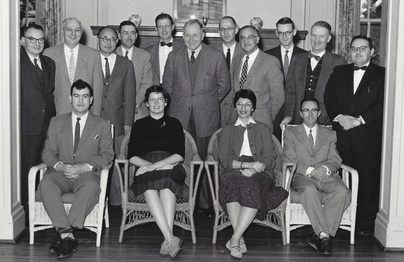 Ray Brook Staff c. 1960
Ray Brook Staff c. 1960
Standing, left to right : Dr. Toole (?), Yeagan, Lawrence, Dr. James Monroe, Fred Beck, John Eisenhauer, Norm Sheffrin, Dr. F. Clark White, Dr. David V. Pecora
Seated: Dr. Agustin Rivas y Zepeda, Dr. Mary Edith Kohl (the only female doctor), Miss Cecilia Slavik Fruhlinger, Dr. Ben Fruhlinger.
Courtesy of Ann Pecora Diamond.
Number of TB Patients To Drop by Half in '65
By PETER W. COX
Within twenty-four hours of the first news of the cutback at Ray Brook State Hospital in April, 1965, residents of the area were talking about doing something about the situation.
Although the formal announcement came unexpectedly, quite accurate rumors on the subject had been circulating for a week. When the rumors were confirmed, the attitude was generally that the closing would be a major economic blow but something could be done to minimize the blow.
The Tuberculosis Hospital will cut back from 200 to 100 beds on April 1, 1965 and the number of employees will be cut correspondingly, although the number to lose jobs will be less than half those presently working there.
Dr. I. J. Brightman, Assistant Commissioner of Health for Chronic Disease Services, said yesterday that the hospital would be cut back to 99 beds. He said that a total shutdown was not foreseen.
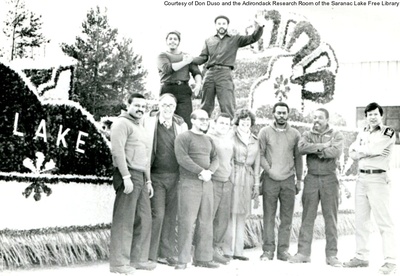 1982 Winter Carnival float work done by Crew 7, Camp Adirondack. Front row, 2nd from left is Village Manager Jack Lawless; 5th from left is Chamber Director Sue Dyer Since maintenance will remain close to the same, most of the maintenance personnel will be retained. The greatest cut back in personnel will be among medical and nursing staff. The number to lose jobs will be less than 125.
1982 Winter Carnival float work done by Crew 7, Camp Adirondack. Front row, 2nd from left is Village Manager Jack Lawless; 5th from left is Chamber Director Sue Dyer Since maintenance will remain close to the same, most of the maintenance personnel will be retained. The greatest cut back in personnel will be among medical and nursing staff. The number to lose jobs will be less than 125.
When the Trudeau Sanatorium closed on December 17, 1954, 125 persons were left without their former jobs. The Ray Brook cutback is the greatest single such action since that time.
As of Friday, March 6, 339 persons in the Saranac Lake area had filed claims for unemployment benefits at the New York State Employment office. The area covers Vermontville, Loon Lake, Bloomingdale, Paul Smiths, Lake Clear, and Saranac Lake.
It is understood that state employees at Ray Brook who lose their jobs because of the cutback will be eligible for unemployment benefits.
There had been no announcement of the planned closing until early in the afternoon Wednesday when Channel 5 in Plattsburgh broke the story.
This newspaper had been in contact with various officials as recently as Wed. morning and had been told at that time that rumors of a possible cutback or closing were not true. When the story was broken on television, others with knowledge of it were willing to speak.
In fact, Assemblyman Grant W. Johnson of Essex County had talked with Dr. Brightman Wednesday morning, at the request of this newspaper, and had been told that there was some truth to the rumor but had been asked to delay any announcement until he heard further from the department of health.
Rumors had been rampant in the area for about a week, but there have been a series of rumors on the subject for some time. Even after the story broke on television, Assemblyman Hayward Plumadore of Franklin County had not been told of the planned cutback but he immediately offered his help in seeking information.
Oneonta legislators had recently spoken for closing Ray Brook, but Assemblyman Johnson had defended the hospital on the floor on the basis that tuberculosis is on the increase, not the decrease.
 Patients at Ray Brook Hospital, c. 1939. From Saranac 1937-1940 by Richard H. Ray
Patients at Ray Brook Hospital, c. 1939. From Saranac 1937-1940 by Richard H. Ray
The budget for the coming year, which amounts to $1,677,288 and is the same as last year, will not be cut until 1965 when it will be reduced in line with the patient and staff cutback.
No one will lose his job before April of 1965, but when persons, whose jobs will not continue after April 1, 1965, retire they will not be replaced. This is also true of patients, as they are discharged, they will not be replaced. This is a standard form of attrition.
In 1965, when employees are released, they will receive priority in other state jobs for which they qualify.
Dr. Brightman pointed out that presently 140 of the 200 patients at the hospital come from New York City and only 60 of them are from what is known as the Ray Brook area. He said that the Ray Brook area would be enlarged, however, so that it could constantly supply enough patients to fill the 99 bed section.
There are two major buildings at Ray Brook and what is commonly known as the "New Building" will be used to house the remaining beds. The New Building was constructed in 1939 while the hospital was originally built in 1904 under the administration of Governor Theodore Roosevelt.
When asked if there were any plans for utilizing the older building. Dr. Brightman said, "the rest of the plant isn't much good." He said that while the state has made them as fire resistant as possible they are still "fire resistant old buildings" and these are not what the state is looking for.
There are two other State tuberculosis hospitals, The Homer Folks Tuberculosis Hospital at Oneonta which was built in December of 1935 and the Mt. Morris Hospital built in March of 1938.
Dr. Brightman said that both of these hospitals had been subject to cutbacks in the number of patients in the last 6 months; they were at 250 and are now at 200; in each a unit was closed.. Dr. Brightman said that the State feels the total of 500 beds will not satisfy their needs for many years.
Assemblyman Johnson spoke with Dr. Brightman a second time Wednesday in the afternoon, when he was told for the first time, in detail, what was happening.
He then called this newspaper to fill in his constituents on what was happening.
"Everybody here is pretty upset, was the word from among the employees at the State Hospital upon hearing the news.
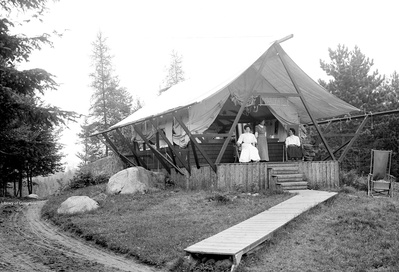 A Typical house tent, state sanitarium, Ray Brook, c. 1909
A Typical house tent, state sanitarium, Ray Brook, c. 1909
William Wigger, Senior Stores Clerk, who has been at the hospital for 24 years, told this newspaper that the men and women at the hospital were expecting major cuts in personnel but they had no idea how many. He said that a week ago, department heads had been called in and asked the minimum number of personnel they would need to operate a 100-bed hospital. Mr. Wigger said this had started the current trend of rumors.
He continued that he had been expecting something like the cutback for ten years but it had been a great shock when it came.
Saranac Lake Bank Vice-President Gordon Partridge took a more optimistic note by saying that the cutback might not be as major a blow as it seems on the surface. In his comment, Mr. Partridge reflected a widespread sentiment that the community has time to compensate for the job cutback.
Mr. Partridge also said that the cutback was not completely unexpected and that the community has been somewhat complacent about Ray Brook.
Mayor John F. Campion of Saranac Lake saw the cutback as a blow to the economy but his attitude was also one of doing something about it. The mayor was on his way to New York to see about a planning grant, and he used his trip as an example of overcoming such setbacks.
Several persons spoke of how people from Ray Brook were good customers and how the cutback would hurt their business, but while the cutback was compared to Trudeau, there was a note of doing something about the situation.
Several times this reporter was told that now was the time to put more effort into future plans to revitalize the economy rather than relying too heavily on what has been in the area for a long time.
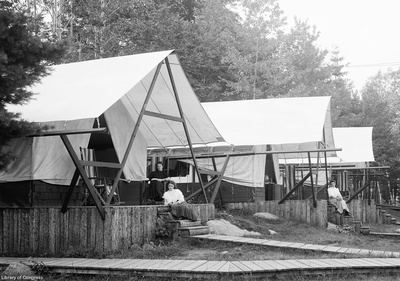 Saranac Lake, Ray Brook state sanatorium, between 1905 and 1920
Saranac Lake, Ray Brook state sanatorium, between 1905 and 1920
Adirondack Daily Enterprise, March 12, 1964
Ray Brook Headed by Dr. Pryor in 1904
The original hospital at Ray Brook was built in 1904 but an addition, the infirmary building was erected in 1939. It is this building that will remain open as a 100 bed unit.
Ray Brook is the first and oldest of the regular state TB hospitals [sic: Massachusetts was reportedly first, and Ray Brook second] and was established largely through the interests of Dr. John H. Pryor of Buffalo whose pioneer efforts ultimately secured legislation for its construction.
Dr. Pryor became first director of Ray Brook Hospital. Dr. James Monroe, present director is the sixth. Second director was Dr. Melvin P. Burnham followed by Dr. Albert H. Garvin, Dr. Harry Bray, and Dr. Frederick Beck.
Dr. Bray was director for the longest period of time, 33 years, when he retired in September of 1950. Dr. Monroe has been director since 1960.
In 1904 Ray Brook had a bed capacity of 150 which included a hillside tent colony and warm weather dwellings for ambulant patients.
In 1910 all departments of the hospital underwent enlarging, the boiler room became the power house at its present site and two new wings were constructed.
In 1911 the first employees building was erected, an annex was added in 1933. The storehouse and refrigeration plant were completed in 1925 and the following year the laboratory was completed. The laboratory was dedicated to a past president of the Board of Visitors, Dr. Frank Erdwurm.
Paint and repair shops were added to the working units of the hospital in 1928 and ground was broken for the new infirmary in 1937.
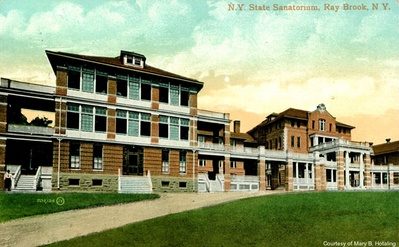 Undated postcard Dr. Herman E. Hilleboe, State Health Commissioner in 1957, speaking at a hearing in Syracuse concerning a proposal to close the Onondaga State Hospital told health authorities that the Ray Brook Hospital and the hospitals at Oneonta and Mt. Morris, “probably will be the hard core group of hospitals we will retain for a long time.”
Undated postcard Dr. Herman E. Hilleboe, State Health Commissioner in 1957, speaking at a hearing in Syracuse concerning a proposal to close the Onondaga State Hospital told health authorities that the Ray Brook Hospital and the hospitals at Oneonta and Mt. Morris, “probably will be the hard core group of hospitals we will retain for a long time.”
At this time in 1957 the Biggs Memorial Hospital in Ithaca was closed and the closing of Onondaga Hospital, Broadacres at Utica and J. N. Adam Memorial Hospital at Perrysburg were anticipated.
It was felt at the time that an important factor in maintaining Ray Brook was that it was one of the most complete hospitals in the state. Dr. Hilleboe said the state would save $2 million by closing Onondaga.
 Adirondack Correctional Facility at Ray Brook from Haystack Mountain looks remarkably unchanged from its years as a tuberculosis sanatorium.
Adirondack Correctional Facility at Ray Brook from Haystack Mountain looks remarkably unchanged from its years as a tuberculosis sanatorium.
In 1957 Ray Brook had 290 employees and 267 patients and an annual budget of over $1,300,000.
The Ray Brook budget in 1960 was $1,542,000 with 267 patients, and 275 employees.
A similar great economic blow hit Saranac Lake in December, 1954 when Trudeau Sanatorium closed.
Severance pay was given the 125 employees when they were released at Trudeau, they were under social security, but not under the New York State Unemployment Insurance Law.
The unemployment from Trudeau, using the 125 figure represented a total of 4.9 per cent of the Saranac lake work force. The unemployment in the Saranac Lake area at the time was 100.
Another 75 employees of the Trudeau Institute were not affected by the Trudeau closing. Ray Brook absorbed many of the unemployed from Trudeau.
Concerning the patients, since no new patients were being admitted, it was anticipated that only about 30 would still be at Trudeau when it closed December 1.
Dr. Gordon Meade who was director of Trudeau when it closed said, "Every effort will be made to assist employees affected by the closing to secure new positions and separation allowances will be made to all and for many of our older employees we hope to be able to supply some pension benefits." Jacques DeMattos who was president of the Chamber of Commerce called a special meeting the following Saturday to consider the Trudeau problem.
Dr. J. Burns Amberson who was president of the Trudeau Board of Trustees commented at the time: "We are now seeing the results of the pioneer work begun here by Dr. Edward Livingston Trudeau more than 70 years ago in the battle against tuberculosis. His untiring efforts were ably carried on by those who succeeded. The result has been a very marked decline in the tuberculosis death rate. "We have witnessed a corresponding decline in the patient census not only at Trudeau but at most private and public tuberculosis sanatoria in this country. In the light, of these changes we feel we cannot justify keeping our patient facilities open.”
Dr. Ben Fruhlinger on hospital:
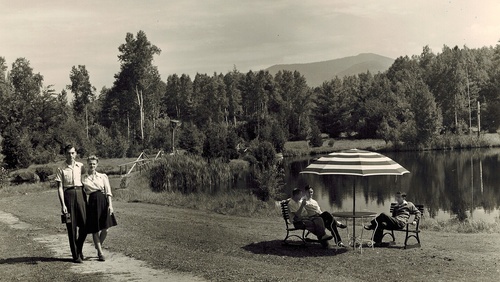 "Country Club" image of hospital.
"Country Club" image of hospital.
Courtesy of Ben Fruhlinger Collection, TCR #124"Dr. Bray and Dr, Trudeau were responsible for making the hospital look like a country club. Mrs. Trudeau (wife of F.B. Trudeau Sr.) did all the decorating. Professor Porter of Cornell University did all landscaping design."
Dr. Ben Fruhlinger in lecture to Practical Nurses, June 19, 1968:
History of Ray Brook - 1904 to 1968
"The hospital you are visiting today has been an institution for the diagnosis, treatment, prevention, and study of tuberculosis since 1904. It was the first State hospital in New York for the treatment of tuberculosis and amongst the first in the United States. More than 25,000 patients have been admitted here during the past 64 years. The history of Ray Brook has been molded by the progress in the management of tuberculosis over the years, and I shall indicate these changes as we go along.
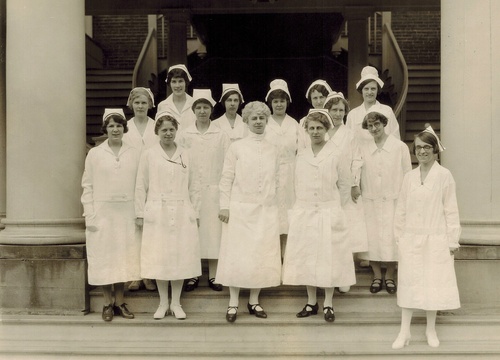 Ms. Cleland and her nurse staff at Ray Brook, 1930-40s.
Ms. Cleland and her nurse staff at Ray Brook, 1930-40s.
Courtesy of Dr. Ben Fruhlinger Collection, TCR #124(Before you is an exhibit by Joseph Kurung picturing the changes in the physical environment of Ray Brook during the past half century. These alterations, and the reasons for them, are inherent in the history of the institution and I shall refer to them in the story that follows.)
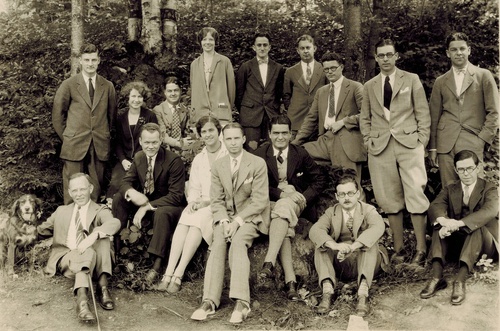 Ray Brook Medical Staff in early 1940s.
Ray Brook Medical Staff in early 1940s.
Courtesy of Ben Fruhlinger Collection, TCR #124How did it come about that the first State hospital for tuberculosis in New York was located in this remote part of the North Country? Perhaps you have already learned of Dr. Edward Livingston Trudeau, a physician who became ill with tuberculosis, and, unable to carry on medical practice, came to the Adirondacks to spend his last years in an environment that he loved -- the great forest, the lakes and streams of the wilderness. The improvement in his own health and two other epic events -- the sanatorium movement in Europe, which emphasized fresh air, good food, and above all, rest for the treatment of tuberculosis, inspired him to establish the first public hospital for treatment of tuberculosis in the United States. (in 1880) Robert Koch in Germany discovered the cause of tuberculosis - a bacteria now termed the tubercle bacillus. These two events provided a reliable and scientific basis for the diagnosis, treatment, and study of tuberculosis. This new knowledge of rest treatment and bacterial recognition of tuberculosis initiated a new and rapidly expanding era in the entire field of tuberculosis.
Dr. Trudeau, with a personal interest in tuberculosis, a knowledge of the disease and an appropriate location for the treatment of patients, made Saranac Lake a gathering place for physicians and patients alike. Saranac Lake became a medical center for the study and treatment of tuberculosis. It was proper that the first State hospital be located here in this area. The emphasis for treatment of tuberculosis in the early 1900s, you recall, was fresh air, good food and, above all, rest.
 New York State Hospital at Ray Brook, undated
New York State Hospital at Ray Brook, undated
Alfred W. Santway Photograph Collection
Courtesy of the Adirondack Experience
The hospital was constructed with these principles in mind. In fact, the first patients were housed in tents on the hill during the summer before the building was completed. Admission to the hospital was limited to those with early or minimal disease, and, therefore, a better chance to recover and return to useful life. Most of the patients were young adults, and, therefore, able or well enough to take care of their personal needs at the hospital, where they remained for an average period of nine months.
Remember, tuberculosis is a chronic disease with a strong tendency to relapse after a period of apparent recovery. Many months were required before a patient was non-infectious and safe to return to their homes. As you might guess, confinement in a hospital, remote from family and friends, posed a major problem in treatment. There was little point in providing a hospital for treatment and isolation of patients if they declined to come here or were homesick and unhappy and left prematurely. This prompted a change in the atmosphere of the sanatorium. It was necessary to make the hospital homelike, comfortable and cheerful so that the patients would be content to remain for the full period of therapy. The interior of the building was decorated and furnished with charm and good taste; special emphasis was placed on the Dining Room, which was redecorated and serviced with linen. Doctors and nurses dined in the same area as the patients. Everyone dressed for dinner, the boys in jackets and ties, the girls groomed, painted, and frocked. There was a white coated waiter at each table. Dining became a social event. After an abundance of good food, well served, the young people looked forward to the evening Social Hour. Most people, of course, were the boys’ visits to the ladies’ solarium for games and conversation. There were also changes outdoors, to encourage patients to walk over the extensive grounds during the morning and afternoon walk hours, to play golf and fish in the brook, and in winter to skate in the pond. The patients were also expected to contribute something towards their own care by cleaning their own rooms and performing some assigned task in hospital maintenance so they would not lose their sense of being able and useful and, therefore, make it easier for them to return to a normal life after discharge from the hospital. With few exceptions, these young people enjoyed their stay at the hospital, which the dubbed “The Country Club”.
You see, treatment of chronic disease required something more than doctors and nurses administering strictly medical care. There was a human and social element to be considered, and that is still recognized today despite the remarkable scientific progress.
This period of rest, fresh air, food and happy environment was essentially unchanged for thirty years. What were the results? Among the patients with early tuberculosis at that time, 2 out of 3 recovered from the disease. This was encouraging but the majority of tuberculosis patients has more advanced disease, and their outlook was less encouraging. Something more was needed(:) therapy. In the 1930s collapse therapy became popular in this country. It was reasoned that if rest to the patient was helpful in treating tuberculosis, rest to the diseased lung itself might be even more beneficial. So, measures were designed to put the lung to rest permanently or temporarily by surgical methods. As a result, in 1939 a surgical unit was constructed at Ray Brook - the Infirmary Building with 100 beds.
For the next twenty or more years, this active service stimulated the Medical and Laboratory sections in research and teaching, as well as administering to the medical needs of the more advanced cases of pulmonary tuberculosis. The rest, treatment and attention to the social aspects were still an essential part of the tuberculosis regimen, and the outlook for previously hopeless cases of tuberculosis was definitely improved, but there was a price to pay in surgical mortality and morbidity, and successful treatment still meant many months away from home and work.
Finally, the chemotherapy era arrived in tuberculosis. SM, Para Aminosalicylic acid, Isoniazid were found to be effective drugs when used properly. This led to a change in both medical and surgical treatment of pulmonary tuberculosis. It was now safe to remove diseased lung rather than collapse it. This meant not only more effective therapy, but also that surgical treatment could be applied to those patients who formerly could not withstand collapse procedures. However, it became apparent from study and experience over years that drugs alone, when scientifically administered, were highly effective in the treatment of tuberculosis, even in the most advanced cases. This brought another change to Ray Brook. The period of hospitalization could now be decreased, and more patients admitted for treatment in a year. Surgery was no longer necessary for most patients. It was no longer necessary to come to the mountains for treatment and, moreover, there were fewer new cases of tuberculosis so in 1965 the Sanatorium Building was closed. Bed capacity was reduced from about 350 to 100 beds, and all the patients were now hospitalized in the Infirmary Building.
The period of hospitalization is much less for most patients. Treatment is relatively simple and highly effective, and many patients can now return to a normal life soon after hospital discharge.
Now, the hospital is preparing a new page in its history. In addition to the treatment of tuberculosis, the Legislature has passed a law that will enable State Tuberculosis hospitals to admit nontuberculous pulmonary disease patients for treatment.
I have traced briefly the history of Ray Brook in relation to the changing trends in therapy. Scientific progress has been highly effective in tuberculosis control but the basic problem remains - the patient himself. He must, as in the past, be persuaded to take advantage of modern treatment, be assisted in making adjustment to several months of hospitalization, be educated with regard to his disease and the necessity for continuing medicine for a year or two after hospital discharge. In short, a chronic infectious disease such as tuberculosis requires more than “magic bullets” for successful prevention and treatment, and nurses and other hospital personnel will continue to have an essential role in the management of these patients.”
 Well Diary... I Have Tuberculosis: Researching a Teenager's 1918 Sanatorium Experience
Well Diary... I Have Tuberculosis: Researching a Teenager's 1918 Sanatorium Experience
Sixteen year old Evelyn Bellak kept a diary while hospitalized in 1918 as a patient with tuberculosis at the New York State Hospital at Ray Brook. She left behind a diary of her experiences there, in the Adirondack Collection at the Saranac Lake Free Library. Shirley Morgan published a book about Evelyn in 2014, titled: Well Diary . . . I Have Tuberculosis: Researching a Teenager's 1918 Sanatorium Experience. This book is available for purchase through Historic Saranac Lake in person and online.
Compiled Information on the Duck Pond
 The duck pond at the New York State Hospital at Ray Brook, New York: In the winter, the pond is frozen so the patients and staff can enjoy skating to music from the radio room. It is a pond in the summer and a skating rink in the winter.The duck pond at the New York State Hospital at Ray Brook, New York: In the winter, the pond is frozen so the patients and staff can enjoy skating to music from the radio room. It is a pond in the summer and a skating rink in the winter.
The duck pond at the New York State Hospital at Ray Brook, New York: In the winter, the pond is frozen so the patients and staff can enjoy skating to music from the radio room. It is a pond in the summer and a skating rink in the winter.The duck pond at the New York State Hospital at Ray Brook, New York: In the winter, the pond is frozen so the patients and staff can enjoy skating to music from the radio room. It is a pond in the summer and a skating rink in the winter.
Adirondack Daily Enterprise, December 14, 2019, Excerpt from Howard Riley's column
Huge cutback at Ray Brook tuberculosis hospital in 1964
by Peter Cox
The Saranac Lake-Lake Placid area will suffer its greatest economic setback since the closing of Trudeau Sanatorium in April of 1954, it was learned Wednesday afternoon. Ray Brook Tuberculosis Hospital cut back from 200 to 100 beds on April 1, 1965 and the number of employees will be cut correspondingly, although the number to lose jobs will be less than half those presently working there.
Dr. J. J. Brightman, Assistant Commissioner of Health for Chronic Diseases told this reporter today that the hospital would be cut back to 99 beds. He said that a total shutdown was not foreseen.
Since maintenance will remain close to the same, most of the maintenance personnel will be retained. The greatest cutback in personnel will be among medical and nursing staff. The number to lose jobs will be less than 125. When Trudeau Sanatorium closed on December 1, 1954, 125 persons were left without their former jobs. The Ray Brook reduction is the greatest single such action since that date.
As of Friday, March 6, 339 persons in the Saranac Lake area had filed claims for unemployment benefits at the New York State Employment office.
It is understood that state employees at Ray Brook who lose their jobs because of the cutback will be eligible for unemployment benefits.
The original hospital at Rey Brook was built in 1904, but an addition, the infirmary building was erected in 1939. It is this building that will remain open as a 100 bed unit.
Ray Brook is the first and oldest of the regular state TB hospitals and was established largely through the efforts of Dr. John H. Pryor of Buffalo whose pioneer efforts ultimately secured legislation for the construction. . . .
In 1957 Ray Brook had 290 employees and 267 patients and an annual budget of over $1,300,000.
In 1960 the Ray Brook budget was $1,542,000 with 267 patients and 275 employees.
Patients' Escape (from Ann Pecora Diamond, daughter of Dr. David V. Pecora, Chief of Surgery at Ray Brook)
You might find it interesting to know something about my father's experiences, trying to keep his patients from going into Saranac Lake in the middle of winter. Many of his patients were alcoholics. There were residents in Saranac Lake who used to deliver alcohol to some of the patients. When other patients were in need of a drink in the middle of winter (which I can remember getting down to -50 degrees at times) they would try to walk into town on their own.
My father had to amputate several fingers and toes from patients who got frostbite from climbing out their windows and down the metal fire escapes in the winter. Each spring, the railroad workers would find the bodies of other patients who made it down to Ray Brook's Post Office, where they attempted to walk into town by following the train tracks. Those poor guys weren't dressed for the weather and invariable froze to death, their bodies buried in the snow until the spring when it melted. I can remember this happening several times. My father was frustrated that he couldn't persuade many of his very sick patients to take care of themselves. He, of course, was a surgeon and not trained to treat alcoholism.
Directors: Dr. John H. Pryor of Buffalo; Dr. Melvin P. Burnham; Dr. Albert H. Garvin; Dr. Harry Bray, who had served the longest, 33 years, when he retired in 1950; Dr. Frederick Beck; Dr. James Monroe; and Dr. F. Clark White, who was the last director of Ray Brook, having previously served as assistant director.
Patients: Dick Ray, Edna C. LaPan, Mary Gloeckner, Blanche Kreymborg, Charles Kolodzey, Frank G. Miller, and Ben Fruhlinger, were patients at Ray Brook.
Employees: Winchester H. MacDowell, Alice V. Keough, Eleanor Bennett, Norman Bethune, Willard L. Utting, Hazel Wright, Tony Brescia, and Edward Mulflur worked at Ray Brook.
See also
- Matthew Annsley
-
Dr. Frederick Beck
- Evelyn Bellak
- Helen Brescia
- Robert Farrell
- Cecilia Slavik Fruhlinger
- Charlotte Geffken
- Emma Guerin
- Dr. Mary Kohl
- Dorothy Peer
- Mike Peer
- Dick Ray
- Russell Shefrin
A patient newsletter at the Ray Brook hospital was called "Woodland Whispers."
Sources *History of the Adirondack Correctional Facility
External links *NY prison information *''New York Times'', "New Mountain Hospital: Institution for treatment of Tuberculosis Almost Ready", October 18, 1903.
Comments
2012-07-06 14:24:51 My grandfather passed away at this place and I am trying to find any one that might have records for the patients back in the 20's or 30's please contact me at [email protected] thank you —71.176.68.210 * Responded 8/10/2012 — LibbyClark
2012-07-24 20:43:21 I am trying to find my father in laws mothers records, she passed away and was a patient in the 1930's if anyone can help with these records please contact me at [email protected] thank you so much —75.131.77.175 * Responded 8/10/2012 — LibbyClark
2013-05-11 12:47:48 ARE THERE RECORDS OF PATIENTS AT RAY BROOK FROM THE EARLY 1940'S? I AM LOOKING FOR MY FATHER'S RECORDS. HIS NAME IS SAM KWIAT. THANK YOU, [email protected] —75.3.241.1
Footnotes
1. Taylor, Robert, America's Magic Mountain, Boston: Houghton Mifflin, 1986. ISBN 0-395-37905-9
2. This article appeared originally on Wikipedia as Adirondack Correctional Facility; its edit history there reflects its authorship. It is licensed under the GDFL.


